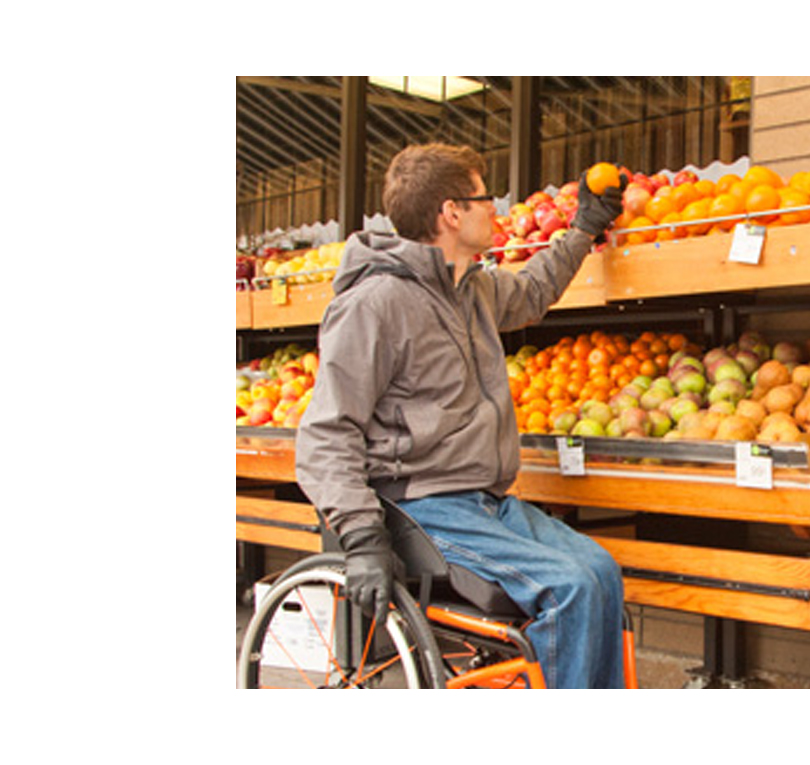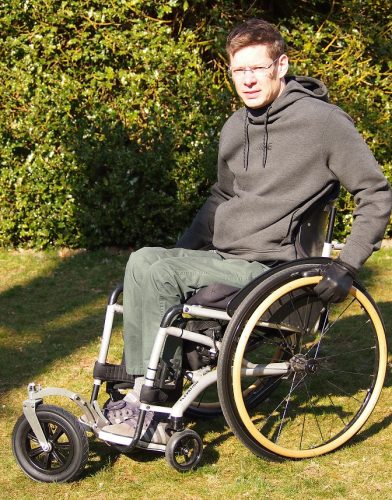In conversation with Praxis SCI Incubate cohort member Elevation Products

Dr. Jaimie Borisoff talks with us about SWIVL™, an innovative technology that helps people with spinal cord injury (SCI) participate in outdoor activities without compromising their indoor mobility.
What led you here in terms of education, experience, and people you met along the way?
Throughout my career, I have focused on how technology development can improve accessibility and mobility for people with an SCI. I am someone who lives with an SCI and have first-hand experience as a wheelchair user for the past 31 years.
I studied engineering physics at university and received a PhD in neuroscience, specifically on spinal cord regeneration. Almost a decade and a half ago, as I focused more on biomedical engineering R&D, I invented a wheelchair design that allowed for real-time seat and backrest adjustments, such as moving up and down and changing seating angles. This gave users the ability to do simple but important tasks like reaching a shelf in the supermarket or wheeling downhill more safely. My invention was called the Elevation Wheelchair, and in 2006 I founded a Vancouver-based company to commercialize it. It is now manufactured and marketed by PDG Mobility.
Today, people from around the world with different disabilities, like spinal cord injury, cerebral palsy and amputation, are using the Elevation Wheelchair. It’s been great to see the success of the Elevation Wheelchair and its impact on the daily lives of people with an SCI.
Expanding people’s ability to interact more fully with others and their community drives a lot of my work. I currently hold the Canada Research Chair in Rehabilitation Engineering Design at BCIT and am a Principal Investigator at ICORD, as well as lead the BCIT Rehabilitation Engineering Design Lab, or REDLab.
Wheelchair users are frustrated by the difficulty in joining family and friends on outings to parks and other areas because of the deficient capabilities of their wheelchairs. With SWIVL, we are hoping to change that.
SWIVL™, “the stow and roll front wheel,” is being developed with help from Praxis’ SCI Incubate program. It is a recent R&D effort that I am bringing to market. The SWIVL is an accessory to make manual wheelchairs more effective in outdoor environments while maintaining overall daily function capabilities.

With SWIVL, users don’t need to carry the device. It’s already attached to the wheelchair, just tucked underneath your frame.
I am really excited about this innovation. It allows users to more fully participate in the outdoors – it’s about making it easier. Users have more autonomy, more spontaneity, without compromising their indoor access. I often hear stories from others that confirm my own experiences. Wheelchair users are frustrated by the difficulty in joining family and friends on outings to parks and other areas because of the deficient capabilities of their wheelchairs. With SWIVL, we are hoping to change that.
What do your customers need, and how are they challenged in their current situation?
Participation in outdoor activities is something most wheelchair users want, but navigating a wheelchair in outdoor terrains – like grass, trails and snow is difficult. Urban outdoor settings, such as canted sidewalks and curb cuts, can also be challenging. Wheelchair castors, the two small wheels at the front of a wheelchair, are one of the major reasons for this. Castors dig into soft surfaces, get stuck and stop your energy. This makes wheeling much harder.
The SWIVL technology we are developing is an “add-on” that lifts the castors off the ground and increases the wheelbase with a bigger tire. It is like having a jogging stroller for kids versus a portable stroller. Users can go for walks, jogs and hikes for leisure health and fitness or even participate in certain jobs that require being outdoors.
Our primary market is the ever-growing number of manual wheelchair users in well-developed jurisdictions, such as North America and Europe. We are also looking at other countries like Japan, Australia, and Israel that have the medical system and social safety nets available to fund the purchase of new innovative mobility devices. This represents a significant market. There are about 200,000 manual wheelchair users in Canada, 1.8 million in the US, and many millions worldwide.
How are you providing a solution to your customer’s needs?
Users can attach the SWIVL add-on themselves while they are sitting in a wheelchair. The SWIVL innovation is that it is installed on the front of a wheelchair and folded underneath the user, beneath the frame, when not in use. Then you can deploy it in seconds by “swiveling” it out and, with a simple “click,” the casters are lifted off the ground for better wheeling outdoors. It then stows back between your legs whenever you want. It’s quick, easy and tidy. Users can shift easily between the SWIVL when outdoors and regular castors when indoors.
I am a wheelchair user, in addition to my 25 years in SCI research and over 15 years as a wheelchair technology product developer. If I need or want something, there is a good chance that others do too.
SWIVL builds off other front-wheel technology in the outdoor wheelchair market. The best known of these products is FreeWheel®. I was one of the first users of the FreeWheel technology when the inventor commercialized it. It’s a great product, but it has a drawback – it doesn’t carry well when its not in use. I often leave it at home and don’t have it when I need it, especially if I decide to do outdoor activity spontaneously. For example, if I am with my kids and they want to go for a walk in the park. With SWIVL, you can have the FreeWheel experience without needing to carry the device and install it when you want to use it. SWIVL can be already attached to your wheelchair, just stowed underneath your frame.
In terms of next steps, we are moving full steam ahead. Our patent application was just filed. We have a business advisory team in place and are now finalizing our product variants with help from the Praxis Consumer Team and testing with some users.
From there, we will move into further prototyping and design the manufacturing process. We are progressing through our general commercialization goals and aim to launch the first product in the third quarter of 2021 to the British Columbia and Ontario marketplaces. We will expand to other markets from there, and are exploring additional uses like pediatric wheelchairs and older adult wheelchairs.
What differentiates your company from the competition?
All the products we develop – from the Elevation Wheelchair to SWIVL and more – are derived from my personal need and desire. I am a wheelchair user, in addition to my 25 years in SCI research and over 15 years as a wheelchair technology product developer. If I need or want something, there is a good chance that others do too. I build these products for myself, and see if others also want them. If they do, then we can develop them further.
As I said before, I have personally used the FreeWheel product for a decade. While it works great, there is a key gap in its functionality that makes it cumbersome for someone to integrate it into their day-to-day life. Having this lived experience allowed me to invent a solution that solves this challenge.
